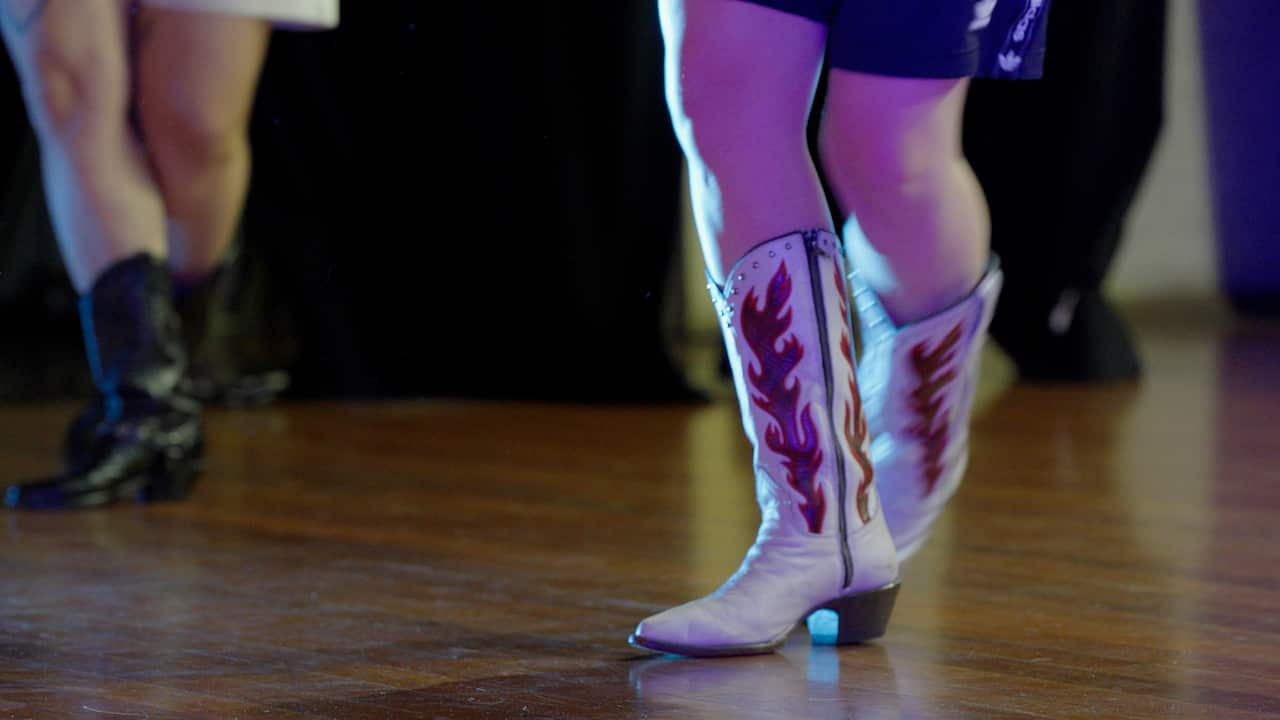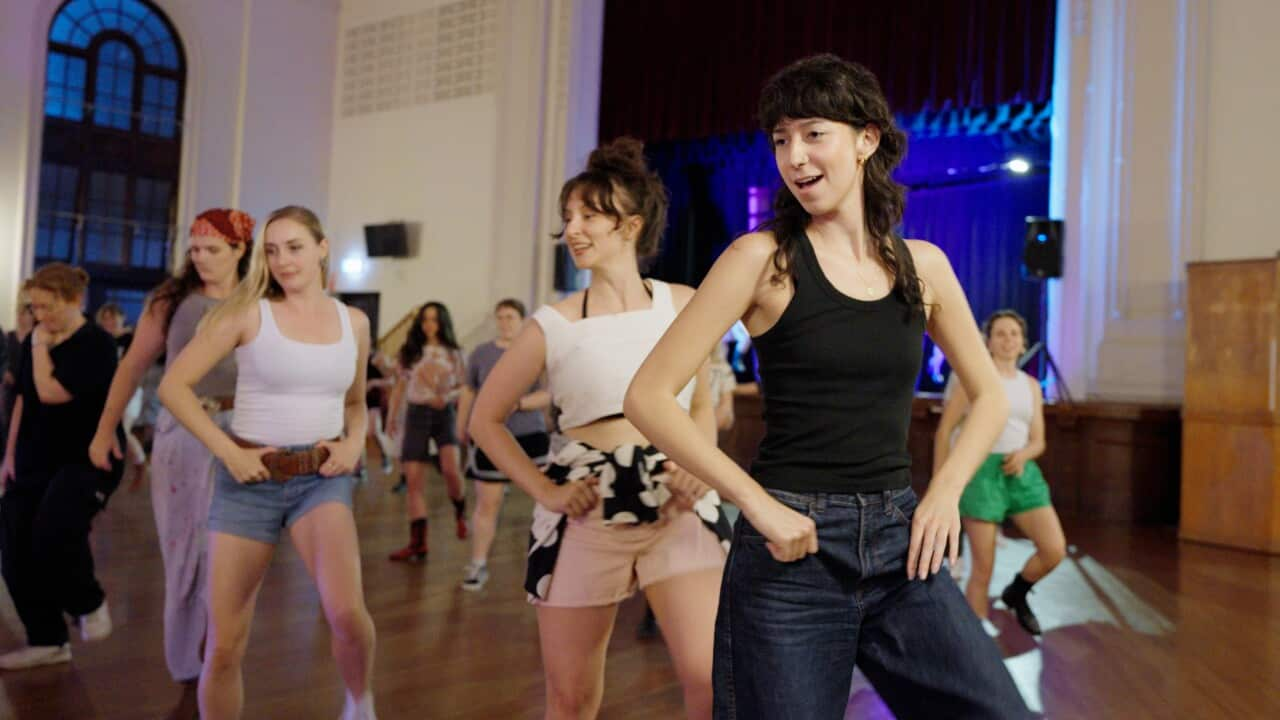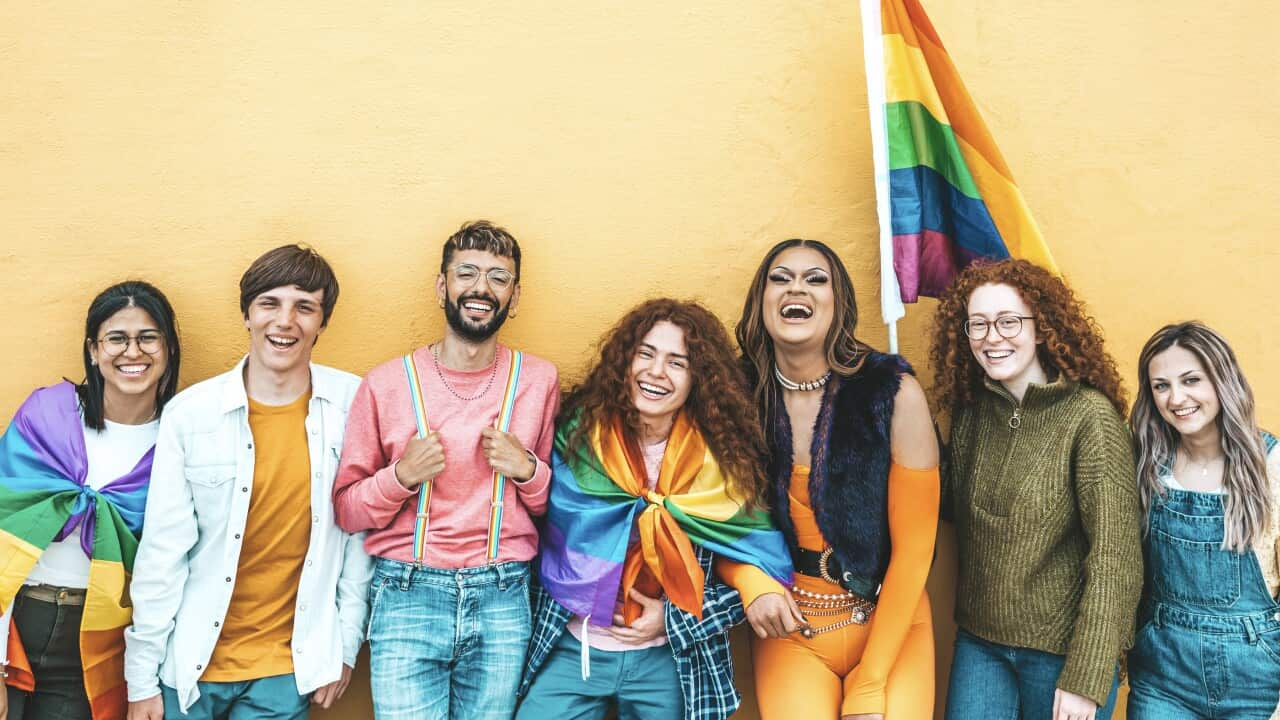It's a Tuesday night and hundreds of people in cowboy outfits are lined up outside Marrickville Town Hall.
They're here for Saddle Club — a queer linedancing workshop in Sydney's inner west.
Rainbow lights line the hall, and stage lights point up at Marzy, Saddle Club's co-founder and choreographer.
"Hello everyone and welcome to Saddle Club. Saddle Club is all about, as much as you can, getting out of your head and into your body; feeling silly, feeling sexy," Marzy says, addressing a roomful of excitable queers.

Saddle Club is for everyone but is queer-led and queer-focused. Source: SBS News / Jack Tulleners
Then the linedancing begins.
Marzy, flanked by Saddle Club backup dancers, demonstrates the steps and the audience follows. It's 45 minutes of stomps, turns and sweat.
Marzy says Saddle Club has a special energy and offers something different for people because it's not centred around drinking alcohol. Mistakes are celebrated and encouraged.
"I think now more than ever, we're probably craving space to be together with our community," she says.
"[Saddle Club] is something that's quite wholesome and activity-driven. And I think it's certainly made us reflect that maybe people are craving that: a space where they can come and have some fun and be very silly, but also get to meet people and socialise in a way that is different to maybe going out on the weekend."
More than linedancing
People flock to linedancing because of the sheer joy it brings, but some are there to meet significant others, Marzy says.
"[There's been] some romances; some bumping into exes. People have often commented that they see half of their dating apps here. I love that. It's so good."
Marzy started Saddle Club in 2024 with a group of friends, who were inspired by Stud Country, which started in 2021.
They thought just 20 of their supportive friends would come.
But it immediately grew to a much-loved weekly event, selling hundreds of tickets.

Marzy, Saddle Club's co-founder, says she grew up linedancing with her mother and grandmother. Source: SBS News / Jack Tulleners
"My mum has always danced. She was also an incredible rock'n'roll dancer, but my mum got my nan into linedancing as a way of keeping fit and healthy and moving her body in a way that was pretty gentle."
She says linedancing became a really special way to connect with family and access joy.
"It's where I feel most myself. And I'm really grateful that that's been passed on from these very incredible, very matriarchal, staunch women in my family," Marzy says.
"I've got this very precious photo of me, my mum, and my nan together in a vest that my mum still has — linedancing. So yeah, it was a cute activity to do together."

A young Marzy linedancing with her mum and grandma. Source: Supplied
Queer bootscooting
Marzy says Saddle Club is for everyone, "but it's certainly queer-driven and queer-led".
"That's been very important to us in kind of creating that space that's safe and celebratory of everything that is queer joy.
"I think having queer-led spaces are really important, where the community can feel seen and feel like it's a space truly for them."

The connection between queerness, linedancing and country music is longstanding, says Marzy. Source: SBS News / Jack Tulleners
"Bootscoot hits Sydney!" reads one headline in The Darlinghurst Area Examiner from 1987.
Crowds of mostly gay men would gather at Sydney's Imperial Hotel and Melbourne’s Mulcahey's to linedance, many inspired by what they'd seen on a visit to the US for the Gay Games.
In 1994, Lesbiana Mag reported that the phenomenon brought together "militant lesbian separatists" and gay men in a way nothing else could.
John Bishop was an early adopter of queer linedancing in Melbourne, becoming a volunteer instructor with the New Frontier Dancing Association, which started around 1989.

An article on bootscooting featured in Campaign Australia magazine, in 1988. Source: Supplied / National Library of Australia
John says it's really great to see a resurgence of linedancing.
"It's a great social activity. It's not a 'meat market' kind of activity like going to a club would be, it's good fun. It allows people to express themselves."
John looks back on linedancing in the late 80s and early 90s as a "wonderful, wonderful time".
"We used to have lines like down the road to get into the classes, which were known as bootscooting," he says.
"It was just gays and lesbians back then, we didn't have all the letters [of the LGBTIQ+ acronym]."
John says the media in the 90s made linedancing seem like a short-term craze or fad.
"The media pounced on it. We had so many magazines and journalists wanting to come to our events and they filmed boots — they were obsessed with boots."

Groups of queers started linedancing in Australia in the mid-80s. Source: SBS News / Jack Tulleners
"I wouldn't put it exactly as a stigma, but it got this: 'Oh no, I wouldn't linedance, that's for old people' kind of reaction."
He says there were different varieties of linedancing, including 'clogging' — a style of dance that involves stomping and striking the floor with one’s heel — and a form of partner dancing called 'two-stepping'.
Men danced with men and women danced with women; women danced with men.
In some instances, partner dancing led to some romances that have lasted over 30 years, according to John.
Marzy says the Saddle Club team have been "completely chuffed" with Sydney’s renewed interest in linedancing.
"It’s been incredible.
"We've been selling out nights, and there's just been this really infectious energy because there's been such a big crowd, and we've been really overwhelmed with the response to the workshops."
She says they have "exciting plans" for 2025, so "watch this space".




